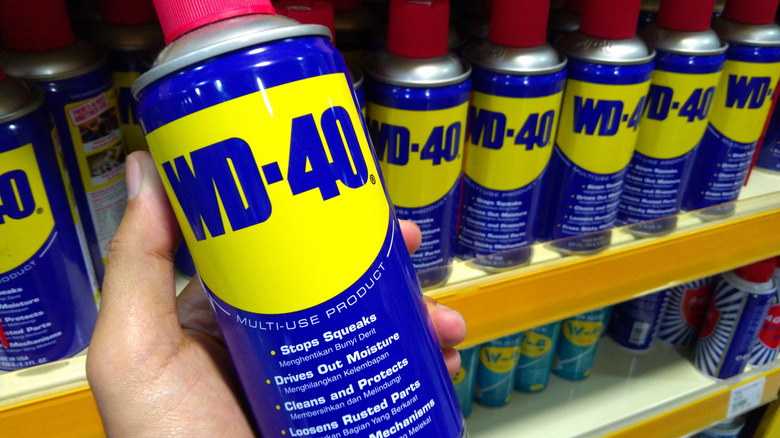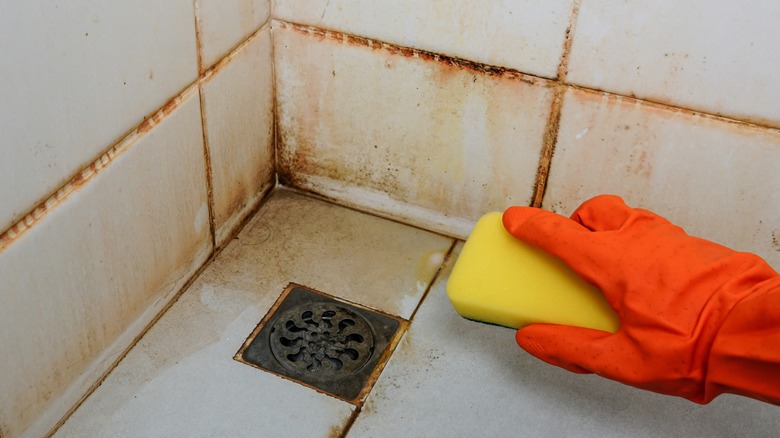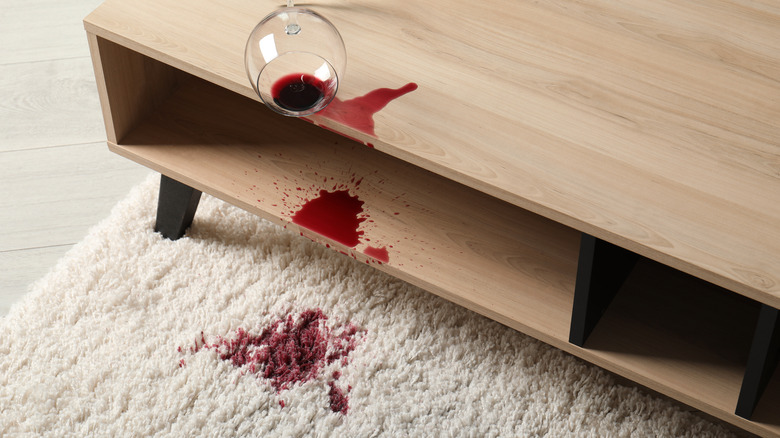Use WD-40 To Remove Tough Stains From Your Floor
Although WD-40 may feel like an amazing product when you use it as a lubricant, as a penetrant, or as an option for removing corrosion, people have developed many other genius tips for using WD-40 at home, making it even more useful. Whether you're using WD-40 to clean up tree sap, help with paint clean up, or condition leather furniture, it is a versatile product. What you may not know is that it works extremely well for removing tough stains from flooring, too. Whether you need to clean tile floors, carpeting, hardwood floors, or vinyl, this lubricant can give you the results you want to see.
It's important to note that there are a few dangers to using WD-40. It is a flammable aerosol, which means it could create a fire. Because the can contains gas under pressure, it could explode if crushed suddenly or if it's exposed to an excessive amount of heat. Should you inadvertently ingest it, it could cause a fatality. Breathing in fumes from the material can cause respiratory problems.
When using WD-40, you may notice an oily smell that remains after the product does the intended job. It also can leave your hands with a greasy feeling that's difficult to remove. To help with odor, only use it in a well-ventilated area. You can sprinkle baking soda in the area to try to absorb the remaining scent as well. There's also a low-odor WD-40 product that you can try.
Cleaning grout and tile floors with WD-40
WD-40 is an effective cleaning product for use on tile floors. When it's difficult to remove scuffs, clean grout, or get rid of soap scum from bathroom tile, WD-40 can do the job. In a bathroom where you may have rust stains or mold on the grout lines, use WD-40 to clean these areas with a lot less elbow grease than you may need when using other products. Spray the lubricant directly onto the grout, aiming it precisely with the straw nozzle. Let it sit for a few seconds before wiping it away with a sponge. If excess lubricant remains on the floor, wipe it away with a rag to fully clean the area.
In addition to cleaning the grout, WD-40 also works well on the surface of the tile. It's able to loosen any sticky and greasy materials, making it easier for you to wipe up stubborn stains. Scuff marks are especially difficult to remove from tile, but spraying WD-40 directly on them can loosen the materials that are causing the marks. You then can wipe them away with a rag. If you have other kinds of stains on the tile's surface, such as paint or nail polish, just spray WD-40 directly on the spot and leave it in place for several seconds. If the stain doesn't wipe away, repeat the process by spraying more lubricant on it.
Removing stains from carpet, vinyl, and hardwood floors with WD-40
Stubborn stains on carpeting are especially frustrating for homeowners, as they're tough to remove. WD-40 does the job with its formula, though. Whether it's a liquid stain, like coffee or wine, or a sticky material, like gum, the lubricant can help you remove it. Start by spraying the WD-40 directly onto the area while holding the can's nozzle a few inches from the carpet. Allow it to sit for up to 30 seconds before doing anything else. Then run a damp sponge over the area where you sprayed the lubricant. This should pull the unwanted material away from the fibers. Wipe the spot with a dry rag to remove any remaining residue.
If you have hardwood floors at your home, WD-40 can help you clean tough stains, while also protecting the wood. It's especially good at removing paint or other materials that simply don't come off easily. Spray the lubricant onto the hardwood surface. Wait a few seconds and wipe it away with a clean rag. If everything doesn't lift away, repeat the process. You also can use a damp sponge for a really stubborn stain after spraying the WD-40. Then come back and use a dry rag.
If trying to clean stains from vinyl flooring, you should spray the WD-40 onto a rag and then wipe the vinyl until the stain disappears. Don't spray it directly onto the vinyl. Use vinegar and water to remove any remaining lubricant.


